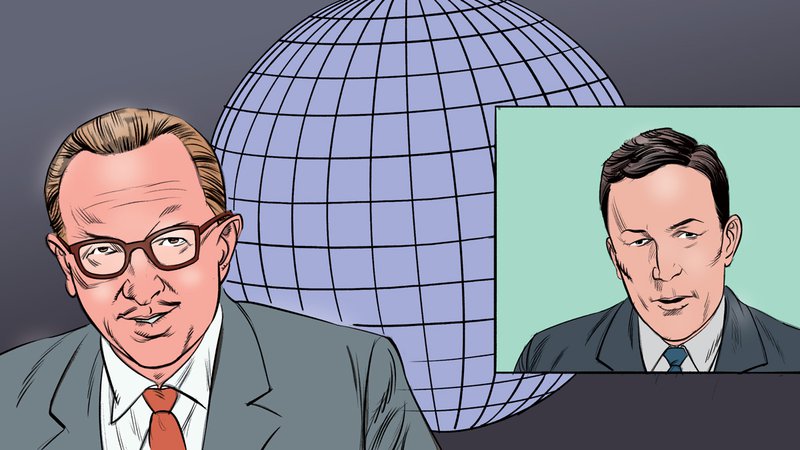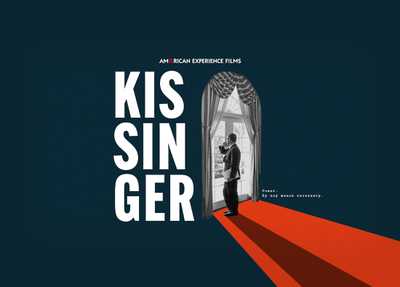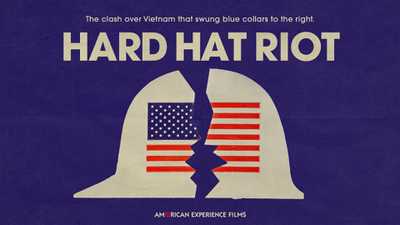Broadcasting the Moon, Part 2: Transcript
View the full graphic comic here.

PANEL 1:
CBS news anchor Walter Cronkite, wearing a gray suit and red tie, says, “Welcome to CBS, Hal,” and leans in to talk to a man seated next to him. They are in front of a big screen showing the Apollo 11 spacecraft.
Text reads: Veteran news anchor Walter Cronkite hosted almost the entire thirty-six hour production. With Cronkite was astronaut Wally Schirra to provide an experienced perspective and to help communicate the more complex aspects of the mission. Finally, joining the CBS team for the first time, was a newly created graphics system dubbed Hal 10,000.
PANEL 2:
Two men, both on the phone, are separated in the comic panel by a coiled cord, indicating they are in two places. Man on the left with dark rimmed glasses holds the phone close and says, “Doug, how would you like to be involved with CBS’ coverage of the Moon landing?” The other man on the phone replies, “Who could say ‘no’ to that?”
Text reads: The 2001-inspired Hal was created by Douglas Trumbull, the man responsible for the ground-breaking visual effects of 2001: A Space Odyssey.
PANEL 3:
Cronkite delivers the news from his anchor desk in front of a graphic of the Earth and says, "Let's check in with Mike Wallace in London…” A small inset on the right shows a close-up of reporter Mike Wallace.
Text reads: At Banow’s request, Trumbull developed Hal to create futuristic display graphics of mission facts for Cronkite to share with viewers. Furthermore, Hal was used to enhance those moments when Cronkite needed to communicate with CBS anchors in other parts of the world.
PANEL 4:
Cronkite listens to his guest, a white-haired man in a suit seated in the studio with him, who says, “I do hope that this great lifting of the spirit which we’ve all experienced today will make a change in morale and help this country get away from the defeatism of the past.”
Text reads: CBS also invited 2001 co-creator and noted science fiction author Arthur C. Clarke to share his perspective on the Apollo 11 mission and beyond.
PANEL 5:
In the studio, a cameraman directs with his index finger as Cronkite talks to a woman wearing aviator shaped glasses.
Text reads: Clarke was one of many celebrity commentators in studio 41 that weekend. Between mission benchmarks, Cronkite interviewed author Kurt Vonnegut, former President Lyndon B. Johnson and journalist and Ms. Magazine co-founder Gloria Steinem. Orson Welles even gave his legendary voice to “History of Space Journeys,” a CBS-produced short film on science fiction.
PANEL 6:
Three split screens show correspondents reporting from various locations. First, a man holding a microphone reports from a space-themed amusement park, another man reports in front of a Wright Brothers-style early airplane, while a third man reports from within a full-size command module model.
Text reads: Beyond the celebrity guests in the U.S., Banow had remote broadcasts coming in from all across the globe. Heywood Hale Broun reported from Disney’s Tomorrowland in Anaheim, California.
CBS’ veteran Capitol Hill correspondent Roger Mudd was in Washington, DC at the Smithsonian Institution aeronautics exhibit.
Correspondents Terry Drinkwater and Bill Stout were in Downey, California with Apollo research pilot Leo Krupp and a full-size mock-up of the command module.
PANEL 7:
Two men in astronaut suits collect samples and take notes on a simulated surface of the Moon in front of a lookalike Apollo lander.
Text reads: Banow’s most elaborate shoot took place at Grumman Aircraft headquarters in Bethpage, New York. Hours before Apollo 11 had even made it to the Moon, CBS’ Nelson Benton guided viewers through a simulation of the landing on a 120- by 125-foot recreation of the moonscape.
PANEL 8:
A closer shot of the surface of the Moon with craters is projected on screen with the words, “240,000 miles from Earth” and “3:51 p.m. The astronauts in lunar orbit”.
Text reads: But the mpressive mock Moon could not compare to the forty minutes of footage received from Apollo 11 in orbit around the Moon. Touchdown was less than twenty-four hours away.
PANEL 9:
Cronkite reports from the anchor desk with four square graphics over his shoulder that display a small ellipse, spiral galaxy of stars, a lava-like eruption and craters on the surface of the Moon.
Text reads: July 20, 1969. Lunar Day programming began with another Reel Three animation sequence depicting the birth of the Moon. Cronkite spent the morning checking in with correspondents around the world, with Banow cutting in at key moments with updates.
PANEL 10:
Inside the television studio, studio cameras and lights all focus on a conveyor belt with the Earth projected on the wall.
Text reads: To illustrate the final descent, Banow positioned a model of the Lunar module above a rolling conveyor belt, made to look like the lunar surface and create the illusion of the module circling the Moon. “It’s an old Holywood trick,” he says from outside the comic panel’s frame. “They used to do the same thing to create the effect of falling rain in soap operas.” Every time the module reached full orbit, Banow would project a scale image of Earth onto the conveyor belt as a point of reference and to recreate the crew’s view of home.
PANEL 11:
With the final separation from the Apollo space shuttle, the Lunar module powers its way toward the surface of the Moon.
Text reads: Mixing live audio transmissions from the astronauts with pre-recorded animation of the final burn, Banow directed an almost perfectly timed descent of the Lunar module despite real time adjustments and course corrections. Years later, Banow would say, “My biggest disappointment was not being able to create multi-angle shots to give the module’s descent a more cinematic feel.”
PANEL 12:
On a static screen, the Lunar module stands on the Moon’s surface. The words on screen read “Time to Lunar liftoff 00:35”.
Text reads: At 4:17 p.m., the Apollo 11 landed on the Moon. CBS viewers’ first sight of the Lunar module at rest—an image that most will never forget—was not live footage from the sea of tranquility…but one of Banow’s simulations.
PANEL 13:
Back inside the studio, two men hover over a tennis ball-size three dimensional model of the Lunar module on a sandy-looking surface with craters. Their faces are illuminated by artificial light.
Text reads: The auto targeting has taken us right into a football field-sized crater. To create a sense of scale, Banow had a diorama constructed with a 1.5-inch scale model of the Eagle module at rest in the center of the enormous crater.
PANEL 14:
An astronaut exits the Lunar module to step down its ladder to the surface of the Moon.
Text reads: At 10:56 p.m., Armstrong exited the Lunar module. All three networks aired the same transmission from the LM’s stationary TV camera. One message broadcast simultaneously across all stations…
PANEL 15:
A footprint of an astronauts’ boot on the surface of the Moon with the speech bubble, “That’s one small step for man…one giant leap for mankind.”
PANEL 16:
An astronaut in full gear stands and stares at a pole bearing the American flag.
Text reads: CBS later learned that more Americans watched their coverage of the Moon landing than the other two networks’ coverage, combined. Ninety-four percent of the country watched at least part of the Apollo 11 coverage on the three networks. By itself, CBS commanded a 24-percent-larger average audience than NBC and 179-percent larger than ABC.
PANEL 17:
CBS anchor Cronkite leans back in his chair and smiles at the camera as Banow sits on the desk next to him. A spotlight in the background illuminates them both.
Text reads: After thirty-six hours of live coverage, CBS news signed off at 3:32 p.m. on July 24. A final credits sequence, the last animated by Reel Three, brought the epic journey of Apollo 11 to a close.
PANEL 18:
A close up of Apollo 11’s emblem shows an eagle carrying an olive branch in its talons with a partial earth projected over a dark starry space.
Text reads: The five-hundred-thousand-mile round-trip journey from Earth to the Moon expanded the scope of human achievement. The space race inspired enormous advances in technology, and it changed the way news was delivered and consumed.
PANEL 19:
A collage of 12 square boxes show a family watching television, CNN logo, six broadcast anchors including Cronkite, George Stephanopolous and Rachel Maddow, and four images of the Apollo 11 mission.
Text reads: CBS spent almost one billion dollars on their coverage of Apollo 11, programming that returned no significant revenue and likely lost money. But continuous network coverage of the Moon mission served as proof of concept for modern news outlets. CBS’ own Robert Wussler left the network in 1978 to join Turner Broadcasting where he would co-found CNN—the first twenty-four hour news network.
PANEL 20:
An imagined scene on the surface of the Moon shows an astronaut in full gear behind a television camera and a woman astronaut standing in front of the camera.
Text reads: Coverage of Apollo 11 humanized the nigh-impossible task of landing a man on the Moon and inspired generations of young scientists and journalists, alike. With modern space enthusiasts at work to make space travel commonplace, could tomorrow’s Joel Banow be directing the news from the Moon itself?
PANEL 21:
Banow, wearing a red t-shirt and arms folded, stands in front of a Lunar module model and the Earth projected in the background.
Text reads: Banow’s innovative Apollo 11 TV production earned him the Director’s Guild of America award in 1970. He continued to oversee CBS’ space coverage until the late ‘70s, when he became freelance director for NBC, ABC and PBS and later founded his own production company in the 1990s—JNB productions.
PANEL 22:
Banow watches the launch of Apollo 17 with crowds of people under the crimson lit night sky.
Text reads: After more than a decade of watching from a monitor, Banow finally observed a spaceshot up close and in person in 1972. Apollo 17, NASA’s one and only night launch, would be the last Apollo mission… “It was absolutely unbelievable.” He wouldn’t have missed it for the world.








